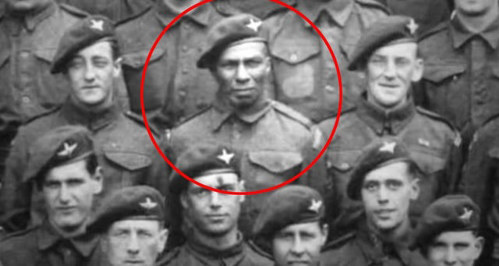05 May 2025
Legacy of Liberation: VE Day & Victory in Europe
The Second World War in Europe could only end one way: the total destruction of Nazi Germany. This is the story of the end of the World War Two war and the final liberation of Europe.
V-E Day
Defeating Nazi Germany

Image: German prisoners taken during crossing of the Rhine operations, 24 March (© IWM BU 2332)
By April 1945, the once mighty German war machine was breaking down.
Suffering enormous losses in the East and West, Nazi Germany’s ability to fight was withering away under constant pressure from the Western Allies and the Soviet Union.
The Battle of the Bulge, German High Command’s last roll of the dice in Western Europe, had failed. American troops, with support from Commonwealth units, had stopped the Ardennes Offensive dead.
Following the failure of the Ardennes Offensive, German forces in the West were harried and pushed over the Rhine.
Then, in March 1945, the Allies had crossed the Rhine, punching into the Fatherland itself. Coupled with the titanic attacks of the Red Army in the east, Nazi Germany was living on borrowed time.
After crossing the Rhine, three Allied armies fanned out across the North German plain: the Canadians turned north into the Netherlands; the British advanced northeast towards the German coast; the Americans pushed east into the Ruhr Valley, Germany’s industrial heartland.
From the Rhine to the Baltic

Image: Aircraft and gliders full of airborne troops about to jump into Germany, 24 March (© IWM CL 2232)
The British 6th Airborne had dropped into Germany as part of Operation Varsity: the largest airborne operation of the war.
Compared to Operation Market Garden, Varsity was a success, providing a springboard for the paratroopers to advance into Germany.
The Paras rapidly moved up Germany on the right of British Second Army as it angled towards Germany’s Baltic coast.
At times, the British covered 40 miles a day – but the advance was not entirely smooth. In some areas, German resistance proved stiff.
Serjeant Sidney Cornell
 Image: Sidney Cornell, circled, with his fellow paratroopers
Image: Sidney Cornell, circled, with his fellow paratroopers
Sidney Cornell was born and raised in Portsmouth on the south coast of England. His father was a former circus acrobat from the United States, while his mother was a gardener’s daughter from Somerset.
Sidney married his childhood sweetheart Eileen in 1934; together, they had three children before Sidney enlisted at the outbreak of war.
Sidney volunteered for the airborne forces and dropped into Normandy ahead of the invasion force on 5/6 June 1944. For his actions in Normandy, Sidney received the Distinguished Conduct Medal. He was described as a “truly magnificent paratrooper”.
After jumping into heavy fire during the airborne part of the Rhine crossing, Sidney and his comrades found themselves in the thick of it once more.
On 7 April, Sidney and his fellow paras had been tasked with capturing the town of Neustad am Rübenberge and its important river crossing. There was one major problem, however: the main road bridge leading into the town had been wired with explosives.
The paratroopers immediately rushed the bridge, hoping to surprise and overwhelm its defenders to keep the bridge intact. Reacting quickly, the Wehrmacht soldiers defending the bridge set off the explosives.
Sidney was one of 22 of his battalion killed that night, aged 31. The missing from the attack at Neustad am Rübenberge are commemorated on the Grosbeek Memorial in the Netherlands, close to the German border.
Sidney and 15 others lie together in plot 15 of Becklingen War Cemetery.
Becklingen War Cemetery

Image: Becklingen War Cemetery, Germany
Some 2,400 servicemen of the Second World War are buried here. Most of them died in the last two months of the war in Europe.
The site was chosen after the war for its position overlooking Luneberg Heath, where Field-Marshal Montgomery accepted a German surrender.
The design emphasizes the view, with the Cross of Sacrifice at the top of the slope above the widest point of the cemetery. Graves were brought here from smaller cemeteries and isolated sites in the countryside.
The cemetery was designed by Philip Hepworth.
The drive to Bremen

Image: Argylls of Canada riding on an armoured personal carrier, Wertle, Germany, 11 April (© Capt Alexander)
While the bulk of the Canadians in Europe were engaged in liberating the Netherlands and Belgium, the 4th Canadian Armoured Division was fighting in Germany under British Second Army.
The Canadian tanks and armoured fighting vehicles were heading for Oldenburg and the North Sea Coast as part of the wider push to the important port city of Bremen.
The low-lying, boggy ground made things difficult for the division’s vehicles, so it fell to the supporting infantry to bear the brunt of the fighting with little armour support.
One such unit was the Argyll and Sutherland Highlanders of Canada (Princess Louise’s).
Lieutenant Colonel Frederick Ernest Wigle
 Image: Lieutenant Colonel Frederick Ernest Wigle
Image: Lieutenant Colonel Frederick Ernest Wigle
The Argylls were commanded by Lieutenant Colonel Frederick Ernest Wigle.
Frederick was born in July 1913 in Ontario, Canada. He attended Trinity College School in Port Hope, before studying commerce and finance at McGill University, Montreal.
At university, Frederick was a Canadian football star, a game like but distinct from American gridiron football.
Like millions of Canadians, he was also a hockey enthusiast, proving as highly skilled on the hockey pitch as on the football field.
Following university, Frederick married his wife Margaret in 1937. He joined the Howell Lithographing Company as its Montreal representative.
Frederick joined the Canadian Army in May 1941 and rose rapidly, first in an armoured unit, before being given command of the Argylls in February 1945.
By all accounts, Frederick was a conscientious officer and well-liked by his men.
His men fought their way to the Rhine before crossing it in March. By April 14, 1945, the Argylls were deep in German, pushing for Oldenburg.
At first light on the morning of the 14th, the Canadians attacked and took the town of Friesoythe. Sadly, Frederick did not survive.
The Argylls’ beloved commander was killed in an attack on his headquarters by a group of German soldiers still free and fighting following the capture of Friesoythe.
Frederick was 31 years old when he was killed. He is buried alongside his fellow fallen Canadian servicemen at Holten Canadian War Cemetery.
Holten Canadian War Cemetery

Image: Holten Canadian War Cemetery, The Netherlands
The great majority of those buried in Holten Canadian War Cemetery died during the last stages of the war in Holland, during the advance of the Canadian II Corps into northern Germany, and across the Ems in April and the first days of May 1945.
After the end of hostilities, their remains were brought together into this cemetery.
Holten Canadian War Cemetery contains just shy of 1,400 Commonwealth burials of the Second World War, a testament to the sacrifice made by so many so far from home in the liberation of Europe.
Bremen and beyond
By 8 April 1945, the leading elements of British Second Army had penetrated some 150 miles into Germany.
Still, they were facing numerous well-defended areas aiming to slow their progress.
Canal and river crossings, vital to the quick progress of vehicles and tanks, were some of the most frequently encountered and heavily defended obstacles in Second Army’s way.
Captain Ian Oswald Liddell VC
 Image: Captain Ian Liddell VC
Image: Captain Ian Liddell VC
Ian Liddell was born in 1919 in Shanghai, China, where his father was a merchant trader. He moved to the UK aged 11, where he was educated at boarding schools in Eastbourne and Harrow, and hoped for a career as a veterinarian.
In May 1940, he joined the army and was soon selected for officer training at Military College Sandhurst.
Ian was commissioned into the Coldstream Guards. He was also selected for Royal protection duties before returning to his unit to train for D-Day.
With the Coldstream Guards, Ian fought in Normandy, took part in the ill-fated Operation Market Garden, and in the slow, hard-fought battles towards and across the Rhine into Germany.
On 3 April 1945, Captain Lidell and his company needed to capture the vital bridge over the River Ems intact. Due to its importance, the bridge was teeming with Wehrmacht troops. It had also been rigged to blow.
Alone, and under intense fire, Ian ran back and forth across the bridge to disconnect all the charges.
Miraculously, he survived and was recommended for a Victoria Cross.
His medal citation gives the following details:
“In Germany on April 3rd, 1945, Captain Liddell was commanding a company of the Coldstream Guards ordered to capture intact a bridge over the river Ems, near Lingen. The bridge was heavily defended and prepared for demolition.
“Captain Liddell ran forward alone to neutralise the 500 lb. charges. Unprotected, and all the time under intense fire, he crossed and re-crossed the whole length of the bridge, disconnecting the charges at both ends and underneath it.
“The bridge was captured intact, and the way cleared for the advance over the river. Captain Liddell's outstanding gallantry and superb example of courage will never be forgotten by those who saw it. This very brave officer later died of wounds subsequently received in action."
Sadly, Ian would not survive the war. The gallant captain was killed by a sniper’s bullet on 21 April 1945, aged 25.
Tragically, Ian was newly wed, marrying his wife some three months before his death. His widow collected his Victoria Cross from the King at a ceremony in Buckingham Palace.
Captain Ian Liddell is buried in Becklingen War Cemetery, Germany.

Image: British tanks and infantry move into the burning ruins of Bremen (© IWM (BU 4356))
Divisions leading Second Army’s vanguard reached Bremen on 20 April. After six days of fighting, the Hanseatic port city was in British hands.
Second Army’s next challenge was to cross the River Elbe southeast of Hamburg. British and Canadian tanks and infantry passed through the area and by 2 May, they had reached the Baltic Sea.
The remaining German forces west of their line from Berlin and central Germany had been cut off.
Elsewhere, American armies were advancing east and southeast through Germany.
On 25 April, at the Elbe near Torgau, American and Soviet troops met face-to-face. Posing for propaganda pictures, the troops from very different worlds met. The mood was jovial, but there was still much bitter fighting left.
Berlin was now surrounded by the Red Army and under constant shelling. Block by block, Soviet soldiers fought their way into the very heart of Hitler’s Reich.
One question remained: When would Hitler and Germany’s senior military leaders be convinced that Allied victory was inevitable?
Liberating the Northern Netherlands

Image: Dutch children celebrate the liberation of their town with the tank crew of a Canadian Sherman Firefly tank of Lord Strathcona's Horse (Royal Canadians) (© IWM)
While Operation Market Garden may not have been the decisive, war-ending operation the Allies had hoped for, it had led to the liberation of the southern Netherlands.
The north, however, was still under Nazi occupation. The task of wresting the Netherlands out of German control was given to the First Canadian Army.
As well as the liberation of the region from the Nazi yoke, the Canadian thrust into the Netherlands was strategically sound. By engaging and defeating the remaining German forces there, the First Canadian Army would also protect the left flank of the Allied armies carving up Germany.
One Canadian corps fought its way north through Arnhem, finally liberating the town which had suffered punishment following the failure of Market Garden. It pushed further onwards to Harderwijk on the Ijselmeer, sending troops to a line just short of Amersfoort.
The second corps worked its way north, liberating Leeuwarden, Groningen, and the northernmost Dutch-German borderlands on the Ems River.
Private John Gerard Spicer
 Image: Private John Spicer
Image: Private John Spicer
John was born in 1923 in Hamilton, Ontario, Canada. He attended the Basilica and Cathedral schools.
After school, John worked for the B. Greeining Wire and the Hamilton Bridge steel fabrication companies. He was still employed by Hamilton Bridge when he left to fight in the Second World War.
John enlisted in the Irish Regiment of Canada which fought in the Canadian 5th Armoured Division.
In late April 1945, the Canadian 5th Armoured was busy clearing German forces out of the northern Netherlands and the Ems estuary.
A German garrison occupied the important port of Delfzijl, still holing out, despite the war's decisive turn in favour of the Allies.
Getting to Delfzijl was no easy task for the Canadian Irish. The approaches were mined and some roads had been demolished wholesale. The Canadians were also targeted by artillery from positions in Emden across the Ems estuary in Germany.
Between 1-2 May, John and his compatriots attacked and cleared German forces out of the Delfzijl pocket. They captured vital lock gates and canal installations intact.
This was the last battle fought by the Canadian 5th Armoured Division. It was, sadly, John’s last battle too. He was killed in action clearing the Delfzijl pocket, aged 21. He is buried in Holten Canadian War Cemetery.
Victory in Europe

Image: Jubilant civilians and servicemen celebrate V-E Day in London, May 1945 (Wikimedia Commons)
On 2 May, the northern Netherlands had been secured and liberated. Berlin, the capital of Hitler’s 1,000-year Reich, was under Soviet occupation. Fascist forces in Italy had surrendered too.
As Red Army soldiers closed in on the Führerbunker, and red flags were raised over a shell-shattered Berlin, Hitler committed suicide. Leadership of the Third Reich was handed over to Admiral Donitz. The writing was on the wall for Nazi Germany.
On 4 May, two German generals surrendered all German forces in the Netherlands, Denmark, and North West Germany to British Field Marshal Montgomery. Later that day, forces in Bavaria surrendered.
When besieged Breslau surrendered to the Soviet army on 6 May, Admiral Donitz agreed the complete and total surrender of all German forces to the Allies, which was signed on 7 May.
8 May was declared ‘Victory in Europe’ day and celebrated across Europe and around the world. Church bells rang. Throngs of revellers crowded streets, singing and dancing.
Each year, V-E Day is marked by ceremonies and celebrations across the UK. But the cost had been enormous.
Hollow Bells
John Betjeman, who would become a Poet Laureate of the UK, wrote a poem remembering a friend who was killed in April 1945, setting it on VE Day. It ends:
‘Stop, oh many bells, stop pouring on roses and creeper Your unremembering peal this hollow, unhallowed V.E. day,- I am deaf to your notes and dead by a soldier’s body…’
For all the rejoicing felt by millions that Nazi Germany had been defeated, for hundreds of thousands the bells may well have sounded hollow, as they already knew their loved one would not be returning.
Betjeman’s dear friend had died fighting the Japanese army in Burma. The knowledge that the war against Japan still had to be won also dampened some VE spirits.
All eyes turned now to the Pacific, where no quick or easy victory seemed likely.
Our work continued…
While the work of the Allied now turned to post-war settlement and retribution, the then Imperial War Graves Commission was facing a huge task.
The new war had instigated a new era for the Commission.
Fresh cemeteries and war memorials were called for, commemorating the hundreds of thousand of servicemen from the British Empire who fell during this world-shaping conflict.
Experience VE Day 80 with Commonwealth War Graves
![]()
If you're like Harvey and have family that served in the World Wars and are commemorated by Commonwealth War Graves, join us for the For Evermore Tour: an exciting nationwide interactive exhibition.
Come and join us as we mark the 80th Anniversary of VE and VJ Day to learn more about your family, local, and national history. We've thousands of moving, inspirational, and stirring casualty stories - and we can help you discover and tell your own.
Visit our VE Day 80 to learn more and find all our events happening near you!

